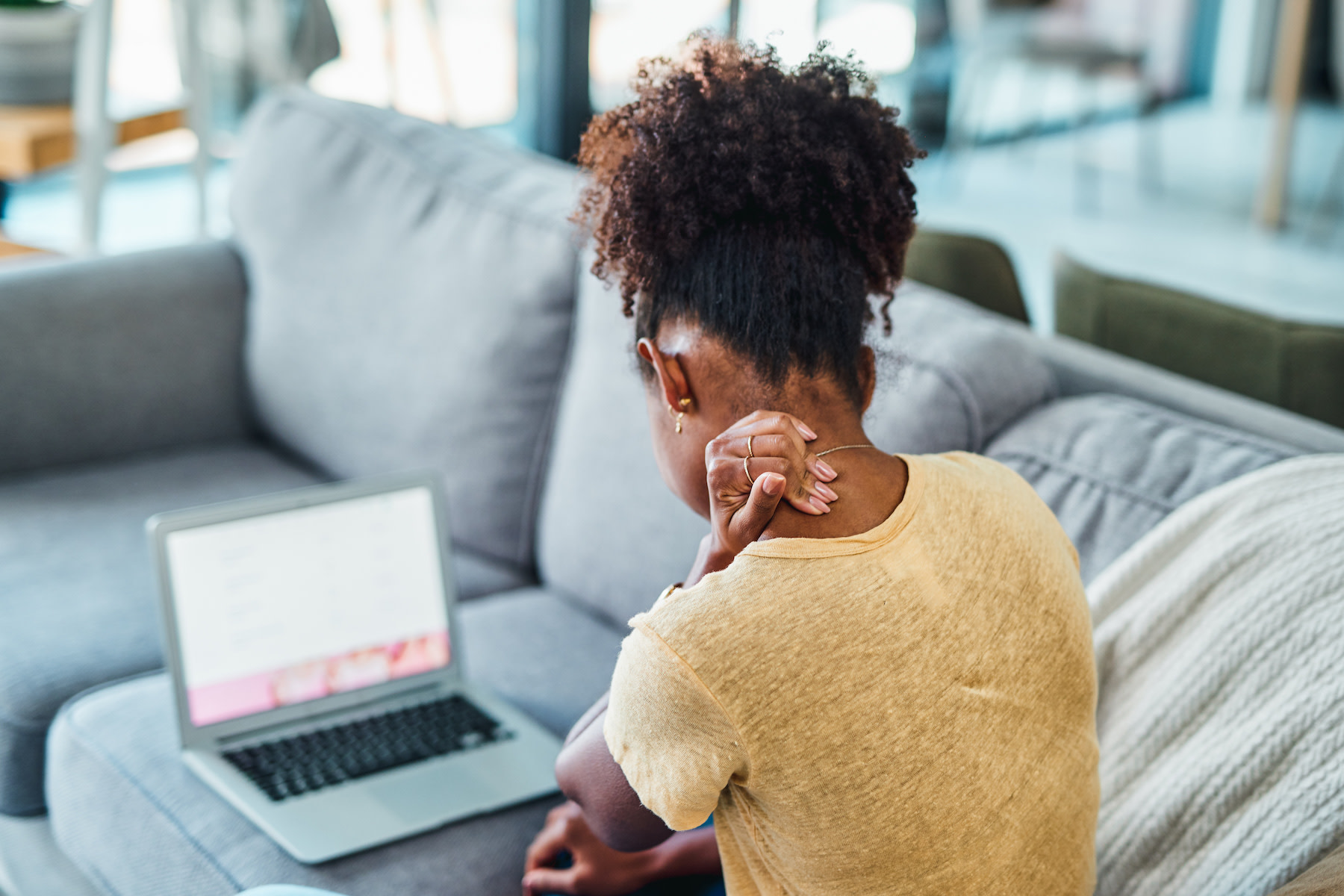
© Luis Velasco / Stocksy United
Are You Experiencing ‘Tech Neck’? How to Tell—and How to Fix It
These expert-led stretches and exercises can provide relief for tech-burdened necks.
By Sara Lindberg•
What Is Tech Neck?
What Are the Symptoms of Tech Neck Syndrome?
How to Get Rid of Tech Neck
Tech Neck Prevention Tips
The Takeaway
Office workers, students, and just about anyone who spends time on their phone or laptop are likely all too familiar with “tech neck.” Even if you haven’t heard the term before, you’re probably familiar with the strain and pain in your neck caused by looking down at your device for too long). While it’s not an official medical term, tech neck can wreak havoc on your body and, if left unaddressed, lead to more serious issues in the future.
The good news? There are obvious signs that point to tech neck, and problems with your posture are easy to spot once you know what to look for. Here’s what experts have to say about why tech neck happens, what you can do to reduce the symptoms, and how you can prevent tech neck from happening in the first place.
What Is Tech Neck?
If you’re not already in tech neck position while looking at your phone or laptop right now, Peloton instructor Ross Rayburn says it’s pretty easy to mimic: “Hold a phone (real or imaginary) in front of your chest, drop your shoulders forward, and shift your chin down and forward a few inches,” he says. “That’s tech neck! It will likely feel very familiar.”
More scientifically speaking, tech neck can also be defined as a protruding head posture that causes a deepening of the cervical extension curve while also causing an excessive forward curvature of the thoracic spine, says J. Bryan Lipana, DPT, a physical therapist.
The idea behind tech neck (also called “text neck”) is somewhat new, but the general concept has been around for a long time, says Kimball Taylor, DPT, a physical therapist and regional director for FYZICAL Therapy & Balance Centers. “It's really all about poor posture,” he adds. The “new” part of tech neck, Taylor explains, is that technology developments over the past 20 years have exacerbated the problem. “Looking down at smartphones, iPads, laptops, and even slouching at your desktop computer exaggerates poor posture, putting more stress and risk on the spine,” he says.
To make matters worse, things like social media and streaming platforms have become so engaging that we may stay in a tech neck position for "sessions that are both far too long and all too frequent in a normal day," Taylor adds.
Spending too much time in this posture increases the forward tilt of the head, causing stress on the cervical spine and surrounding muscles, leading to pain and other potential issues on the neck and upper spine. And while we all contort our head and neck into this position at some point, tech neck becomes a problem when it leads to tech neck pain.
What Are the Symptoms of Tech Neck Syndrome?
Giving up electronic devices is not in the cards for many of us. For better or worse, we live on our screens for several hours a day. That said, understanding the signs that indicate a worsening problem can help you determine if tech neck pain is settling in.
The common symptoms of tech neck include:
Neck pain
Neck and upper back stiffness
Shoulder discomfort
Headaches
Inability to hold your neck in the proper posture
Strained or weak neck muscles
While the occasional achy neck might not be a cause for concern, living with chronic symptoms may lead to other problems if they’re not addressed. “Neck and back stiffness and pain are just the beginning,” Taylor says. “As we go further down that path, it's common to have more nerve compression issues in the spine and shoulders, which can lead to numbness, tingling, and radiating pain in the extremities.”
Additionally, Lipana says chronic tech neck may evolve into more serious headache issues like cervicogenic headaches and/or dizziness caused by the compression of nerves and abnormal muscle tension.
Taylor says chronic tech neck can also lead to scoliosis or kyphosis, which are diseases where the spine isn't holding its normal shape. “In extreme cases, these conditions can require surgery to correct,” he notes. “In milder cases, you may live with a deformity in your spine.”

Moyo Studio / E+ via Getty Images
How to Get Rid of Tech Neck
Tech neck doesn't show up unexpectedly. Most of the time, the discomfort is brewing, but the pain doesn’t surface until your body is really out of alignment. Fortunately, you can reduce the symptoms and keep tech neck at bay with the right stretches, exercises, and posture adjustments.
There are big benefits of addressing tech neck head-on (pun unintended). For starters, “your neck and shoulders will have less pain and more mobility,” Ross says. “One example is being able to turn your head to back out of a parking space when driving with ease.”
Ross Rayburn’s Tech Neck Refinement Movements
Below, find some of Ross’s go-to refinement movements, or “fixes,” to help with tech neck. A quick side note before trying these tech neck moves: They might feel a bit unusual at first, Ross says, but once you get used to them, they’re actually pretty simple to do.
Puff up your chest and upper back across the back of your shoulders like you’re making fun of a cartoon superhero. Think of this as the pedestal for the neck and the head.
Stand at “military-like” attention. To get into this position, slowly slide your shoulders back. You will notice your collarbones broadening. The top of your head (imagine wearing a level crown) will be so far back that if you were standing in front of a wall, the back of your head would touch it.
Tuck your chin toward your chest (look at a spot), tilt your chin up until your neck first signals “stop” (look at a spot), then lower your chin to just above the halfway point between those two spots. Again, Ross says this might feel weird, but that’s the angle of your head and the direction of your vision.
Ross also likes practicing two specific exercise variations while doing the above steps to employ a bit of feedback and resistance, which makes the muscles “remember” the new position more readily:
Exercise Variation #1
Stand with your hands interlaced behind your head (think relaxing on a beach, except standing up) and do the three steps above.
Exercise Variation #2
Bend your elbows like robot arms and pretend that you have a ponytail that gets caught on the upper door frame as you walk through. Ross says the above three steps then almost happen as a result of the door frame holding onto your imaginary ponytail.
More Tech Neck Stretches and Exercises
When aggravating tech neck symptoms won’t go away, sometimes you need more than just a break from screens to find relief. Exercises designed specifically for the neck area can help alleviate pain while also stretching and strengthening your upper body. Here are a few of Lipana’s favorite moves to eliminate tech neck pain:
Chin Tuck
Draw your head straight back so that your ears line up with your shoulders.
Hold this position for 10 seconds.
Repeat two to three times or throughout the day for relief.
Doorway Chest Stretch
Stand in a doorway.
Place your arms on the sides of the door.
Put one foot in front of the other and slowly shift your weight forward until you feel a stretch along the front part of your chest and shoulders.
Hold for one minute.
Repeat two to three times or throughout the day for relief.
Scapular Pinches with Thoracic Extension
Clasp your hands behind your back.
Pinch your shoulder blades together and push your chest forward.
Hold for one minute.
Repeat two to three times or throughout the day for relief.
Of course, if you have any questions or concerns, reach out to a physical therapist or doctor. “There are innumerable variations of tech neck, and no two necks are the same,” Ross notes. If you continue to have symptoms, Taylor says you may benefit from a personalized physical therapy program to address the stiffness and restore motion and strength to the injured spine.
Tech Neck Prevention Tips
Now that we’ve covered how to deal with tech neck while it’s affecting you, let’s take a look at how you can prevent it from happening in the first place.
If you’re going to be on a screen, Taylor recommends the following posture tips:
Put your hips all the way to the back of the chair.
Retract or move your shoulders and chin black to improve spine and neck position.
Find a way to elevate the screen to roughly eye level.
Holding a smartphone with your arms high can work for a little while, but keeping them there is difficult. Setting your phone up on a platform can offer a better height without fatiguing your arms. Alternatively, you can support your arms with a pillow or a box. When you’re working on a laptop, consider using a separate monitor or keyboard so your eyes and spine don't have to curve down to a low screen.
Another helpful tip from Taylor is to have a friend or coworker take a side picture of you when you least expect it. “Most of us are very unaware of how bad we might look while on our phones,” he says, explaining that seeing is believing and looking at the photo (even if it feels cringe-worthy) is a good place to start for working on your posture.
Additionally, Lipana says taking breaks is key to preventing tech neck from happening in the first place. That’s why he recommends standing up and looking away from your screen in different directions while moving your neck. If possible, aim to do this once every 30 minutes while using a device.
Lipana also stresses the importance of posture and ergonomics when trying to prevent tech neck, and reinforces that ideally, your screen should be at eye level so your neck is in the most neutral position. “A neutral position allows the joints in your neck to have the largest volume and the least compressive forces,” he explains. “It also means the compression of the cervical vertebra is evenly distributed and the neck muscles are at their resting length, not overly stretched or shortened.”
The Takeaway
If you’re dealing with tech neck and having painful or stiffness symptoms, Taylor says the first step is to stop the damage. Following the guidelines outlined in this article should help to stop your tech neck from getting worse, and hopefully, keep it from coming back. But if your symptoms just won’t go away, it might be a good idea to consult a physical therapist. They should be able to help relieve your stiffness and restore motion and strength to your spine.
This content is for informational and educational purposes only and does not constitute individualized advice. It is not intended to replace professional medical evaluation, diagnosis, or treatment. Seek the advice of your physician for questions you may have regarding your health or a medical condition. If you are having a medical emergency, call your physician or 911 immediately.
Level up your inbox.
Subscribe for a weekly dose of fitness, plus the latest promos, launches, and events.